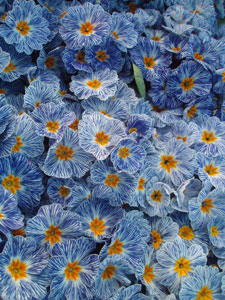2/27/2013
A Primula of a Different Kind
Jessica DeGraaf

Aptly named, Primula Blue Zebra offers a fresh, invigorating twist to the
Primula acaulis market. Gone are the days of the same old monochromatic colors and flame patterns. A 2011 Fleuroselect Medal winner, this F1 primula offers something new and unique to the early spring sales window. Pure white flowers provide the perfect backdrop for deep blue leaf veins and a bright yellow eye. This striking combination creates a zebra effect that retailers and consumers love! Primula Blue Zebra is exclusive to the Hort Couture program.
- Height and spread: 8 to 10 in.
- USDA Hardiness Zones: 4 to 9
- Blue Zebra is a mid-season variety and bloom time is January to April.
Media and pH Blue Zebra requires a well-drained, soilless media with a pH of 5.5 to 5.8 and an E.C. range of 1.0 to 1.5 (using a 1:2 extraction method). Ensure that the newly transplanted liner is even or slightly higher than the media level of the new container.
Moisture Liners should be kept moist upon transplant, but they shouldn’t be oversaturated. Once sufficient rooting has occurred, begin to allow media to dry down between irrigations. Provide horizontal airflow to aid in drying the media down through evapotranspiration. Avoid watering late in the day to prevent foliar diseases.
Temperature Maintain day temperatures of 60 to 65F (15 to 18C) and night temperatures of 55 to 60F (12 to 15C) for three to four weeks. After roots have established and plants have six to eight true leaves, lower temperatures to 40 to 50F (4 to 10C) for six to eight weeks. This cooling period is necessary and promotes flower bud initiation. Note that a juvenile plant will not respond to cooling, resulting in a blind plant. Plants must have six to eight true leaves prior to transitioning plants to cooling. After cooling, grow on at 50 to 60F (10 to 15C). Flowering will occur in roughly three weeks after cooling period. Excessively warm temperatures reduce the striping effect and cause variability in flower size and appearance.
Light Maintain light levels of 3,000 to 3,500 footcandles to promote the best growth. Long days may enhance growth. Avoid direct sunlight as leaf scorch may occur.
Humidity 40 to 70%
Fertilizer Use an N:K ratio of 1:3 to finish plants. Alternate between calcium-based (14-4-14) and nitrate-based fertilizers (19-6-20) at 100 to 150 ppm nitrogen. As primula are produced under cooler temperatures, maintain low ammonium levels, which will reduce excessive vegetative growth.
Growth regulation Blue Zebra is naturally compact and requires very little, if any PGR application. If needed, an application of B-Nine (Daminozide) can be applied as a spray at 2,500 ppm.
Pests and diseases Maintaining good cultural and IPM practices throughout the production of Blue Zebra will greatly decrease the incidence of the following pests and diseases: Aphids, whiteflies, fungus gnats, thrips, leaf miners, Ramularia and Botrytis. Preventative fungicides can be applied to combat this. Always refer to the manufacturer’s label for proper application rates.
Crop timing
From 285 plug tray: 4.5-in. (11-cm) container—15 weeks from transplant to flower
From 36 strip tray: 4.5-in. (11-cm) container—12 weeks from transplant to flower
GT
Jessica DeGraaf is Program Coordinator for Hort Couture. For more information on where to purchase Primula Blue Zebra, visit www.hortcoutureplants.com.